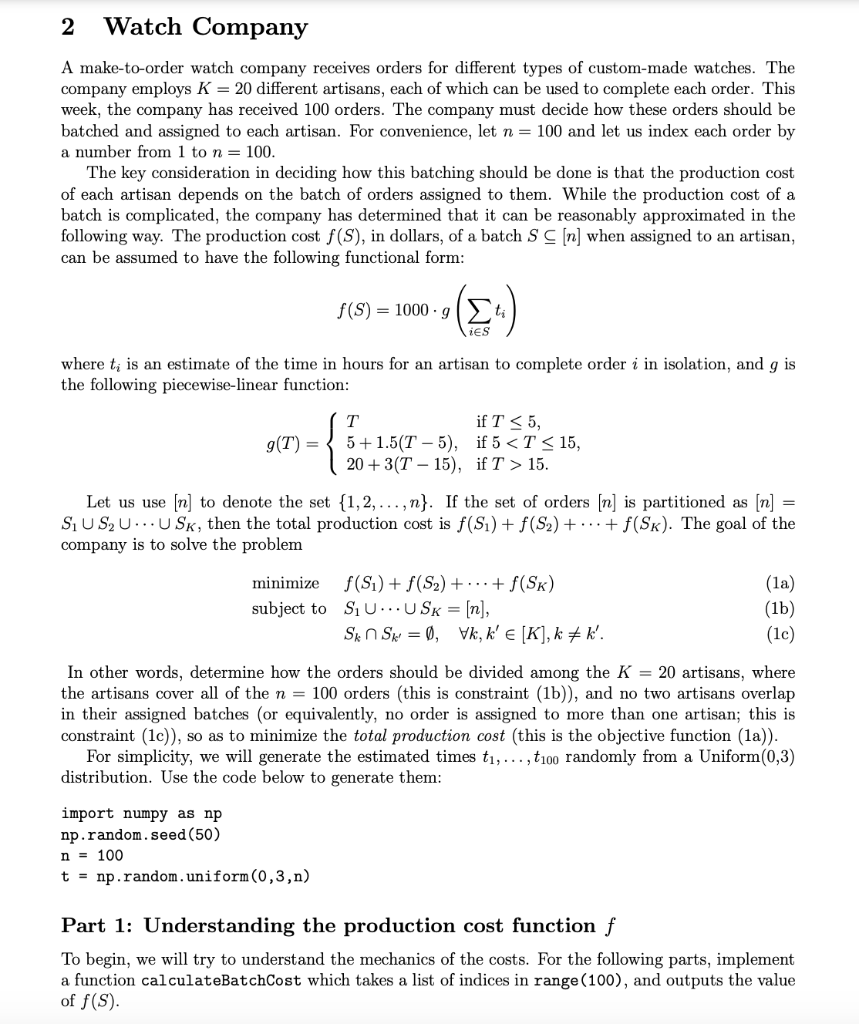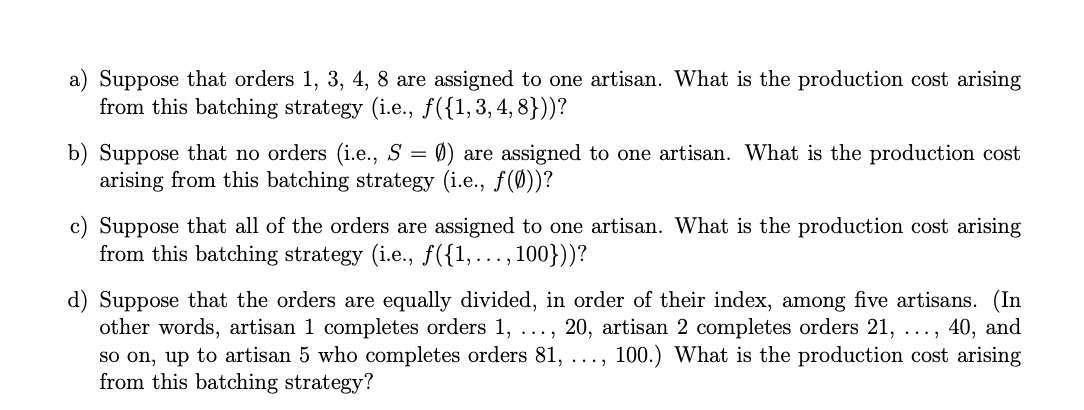

2 Watch Company A make-to-order watch company receives orders for different types of custom-made watches. The company employs K=20 different artisans, each of which can be used to complete each order. This week, the company has received 100 orders. The company must decide how these orders should be batched and assigned to each artisan. For convenience, let n=100 and let us index each order by a number from 1 to n=100. The key consideration in deciding how this batching should be done is that the production cost of each artisan depends on the batch of orders assigned to them. While the production cost of a batch is complicated, the company has determined that it can be reasonably approximated in the following way. The production cost f(S), in dollars, of a batch S[n] when assigned to an artisan, can be assumed to have the following functional form: f(S)=1000g(iSti) where ti is an estimate of the time in hours for an artisan to complete order i in isolation, and g is the following piecewise-linear function: g(T)=T5+1.5(T5),20+3(T15),ifT5if5
15 Let us use [n] to denote the set {1,2,,n}. If the set of orders [n] is partitioned as [n]= S1S2SK, then the total production cost is f(S1)+f(S2)++f(SK). The goal of the company is to solve the problem minimizesubjecttof(S1)+f(S2)++f(SK)S1SK=[n],SkSk=,k,k[K],k=k In other words, determine how the orders should be divided among the K=20 artisans, where the artisans cover all of the n=100 orders (this is constraint (1b)), and no two artisans overlap in their assigned batches (or equivalently, no order is assigned to more than one artisan; this is constraint (1c)), so as to minimize the total production cost (this is the objective function (1a)). For simplicity, we will generate the estimated times t1,,t100 randomly from a Uniform (0,3) distribution. Use the code below to generate them: import numpy as np np.random. seed(50) n=100 t=nprandom uniform (0,3,n) Part 1: Understanding the production cost function f To begin, we will try to understand the mechanics of the costs. For the following parts, implement a function calculateBatchCost which takes a list of indices in range(100), and outputs the value of f(S). a) Suppose that orders 1,3,4,8 are assigned to one artisan. What is the production cost arising from this batching strategy (i.e., f({1,3,4,8})) ? b) Suppose that no orders (i.e., S=) are assigned to one artisan. What is the production cost arising from this batching strategy (i.e., f()) ? c) Suppose that all of the orders are assigned to one artisan. What is the production cost arising from this batching strategy (i.e., f({1,,100})) ? d) Suppose that the orders are equally divided, in order of their index, among five artisans. (In other words, artisan 1 completes orders 1,,20, artisan 2 completes orders 21,,40, and so on, up to artisan 5 who completes orders 81,,100.) What is the production cost arising from this batching strategy? 2 Watch Company A make-to-order watch company receives orders for different types of custom-made watches. The company employs K=20 different artisans, each of which can be used to complete each order. This week, the company has received 100 orders. The company must decide how these orders should be batched and assigned to each artisan. For convenience, let n=100 and let us index each order by a number from 1 to n=100. The key consideration in deciding how this batching should be done is that the production cost of each artisan depends on the batch of orders assigned to them. While the production cost of a batch is complicated, the company has determined that it can be reasonably approximated in the following way. The production cost f(S), in dollars, of a batch S[n] when assigned to an artisan, can be assumed to have the following functional form: f(S)=1000g(iSti) where ti is an estimate of the time in hours for an artisan to complete order i in isolation, and g is the following piecewise-linear function: g(T)=T5+1.5(T5),20+3(T15),ifT5if515 Let us use [n] to denote the set {1,2,,n}. If the set of orders [n] is partitioned as [n]= S1S2SK, then the total production cost is f(S1)+f(S2)++f(SK). The goal of the company is to solve the problem minimizesubjecttof(S1)+f(S2)++f(SK)S1SK=[n],SkSk=,k,k[K],k=k In other words, determine how the orders should be divided among the K=20 artisans, where the artisans cover all of the n=100 orders (this is constraint (1b)), and no two artisans overlap in their assigned batches (or equivalently, no order is assigned to more than one artisan; this is constraint (1c)), so as to minimize the total production cost (this is the objective function (1a)). For simplicity, we will generate the estimated times t1,,t100 randomly from a Uniform (0,3) distribution. Use the code below to generate them: import numpy as np np.random. seed(50) n=100 t=nprandom uniform (0,3,n) Part 1: Understanding the production cost function f To begin, we will try to understand the mechanics of the costs. For the following parts, implement a function calculateBatchCost which takes a list of indices in range(100), and outputs the value of f(S). a) Suppose that orders 1,3,4,8 are assigned to one artisan. What is the production cost arising from this batching strategy (i.e., f({1,3,4,8})) ? b) Suppose that no orders (i.e., S=) are assigned to one artisan. What is the production cost arising from this batching strategy (i.e., f()) ? c) Suppose that all of the orders are assigned to one artisan. What is the production cost arising from this batching strategy (i.e., f({1,,100})) ? d) Suppose that the orders are equally divided, in order of their index, among five artisans. (In other words, artisan 1 completes orders 1,,20, artisan 2 completes orders 21,,40, and so on, up to artisan 5 who completes orders 81,,100.) What is the production cost arising from this batching strategy








